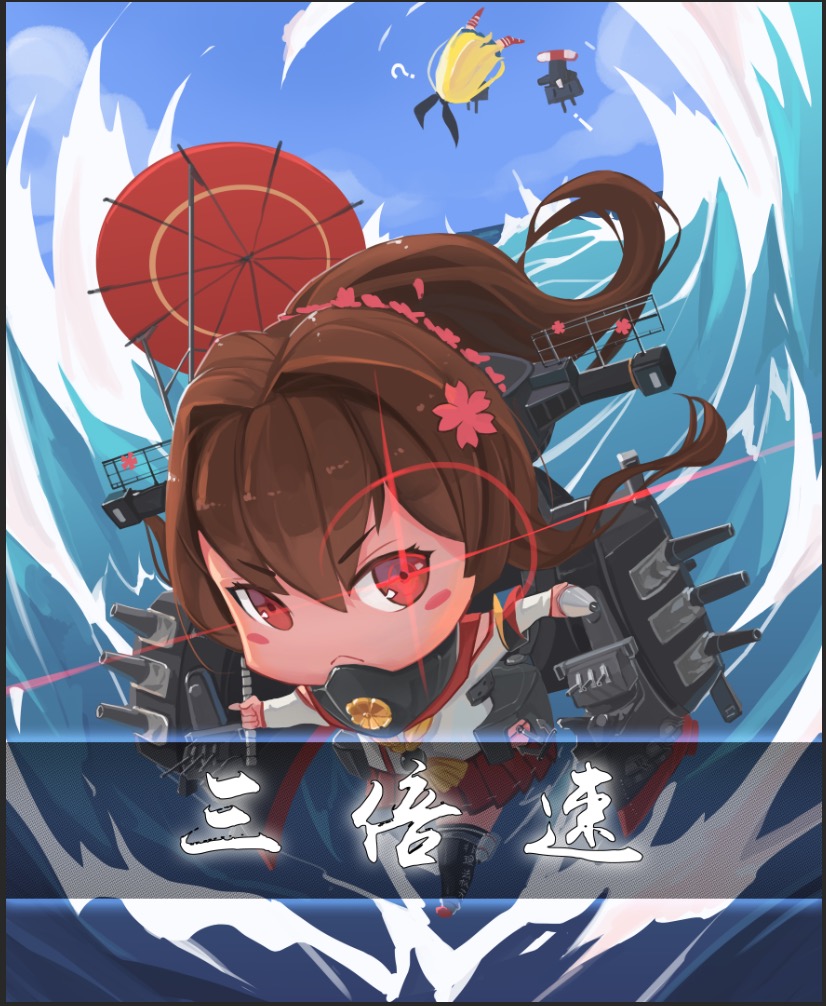
Everyone paying attention? It’s so much easier to be out of universe. I don’t have to, ugh, play a character all the time.
Because, I think, I’m about to ask a fairly interesting question: to what extent should a shipgirl’s “ship” self define her combat limitations?
I’ve seen a fair bit of works that do something like this. Shipgirls are entirely limited by their historical counterparts, with no “particular” way to upgrade. In this sort of setting, a shipgirl is closer to their “historical” roles of combat, where there is a strict order or limitation of engagement. Generally, due to the “historical” nature, shipgirls frequently take upon significant inhuman characteristics, be it consuming steel or other materials, are physically the same weight (more or less) as their historical counterparts, and so on.
I think this is the easiest to write, and the best for authors who are interested more in the military hardware aspect of the shipgirls. A good example of this that I’ve seen involves a sort of Girls und Panzer like battle “system,” where the shipgirls themselves act as larger-than-life champions of their respective countries and wars are settled via shipgirl to shipgirl combat. In this particular setting, points are assigned based on a number of metrics, including clothing damage and other components.
My thoughts are, though, is that something like this inevitably creates a very unique challenge for the author if they want to address the typical Abyssal vs. Shipgirl conflict.
Why bother with the weaker shipgirls?
Why bother say, putting someone like a Fusou into the story, when you can have me? Why not have a million of me, which, you know, is obviously the greatest battleship the world’s ever seen?
See, I know what you want to say. There’s always one of these sort of stories where using superior training, discipline, courage, mental strength, or whatever else plot armor you want to give to your protagonist, your protagonist party overcomes the whatever bad guy thing opponent that you fight. I’m not saying that you can’t do that. But, to me, I feel like to use that sort of plot in this sort of setting would be very jarring. After all. My expectations are along the lines of military “specs,” and military hardware is one of these things where the technology does matter. In fact, the tech matters a lot. Do you know what sixteen or eighteen inchers (that’s what you Americans call naval guns, right?) do to destroyer or escort armor? Do you know how much fire a battleship can vomit out against a single target?
I think the author’ll have to be a lot more creative to recreate the types of events that happened historically. For instance, in real life, Hiei was unable to do much to the O’bannon because it was shooting the wrong ammo and its main guns were too high to hit a destroyer. I can believe the first one if we have a situation of shipgirl on shipgirl combat, but it’d be REALLY hard for me to believe the second one when you know, the guns are angled on a person-sized object.
Seriously I think if you like, made a few strange poses you should be able to hit any angle you want. Get my point?
Or, again (sorry, not to pick on you O’bannon, but you’re literally the best example fo rthis sort of thing) with O’bannon and her submarine episode. In that situation where the two ships are nearly colliding onto each other, I don’t think we’d have gone down to potatoes. Shipgirls have arms and legs! Just smack her! Show them what your fists are made out of!
So, in that sense, we do things slightly differently here. In the Pacific setting, you can see it as the opposite, where THEORETICALLY there should be little limitations to a shipgirl’s capacity to change equipment. I wake up on the wrong side of the bed and decide to outrace Shimakaze? I can do that.
I think. Hey, Tautog! Is that canon – the page image?
Well, you did wake up on the wrong side of the bed and decided on a whim that you were going to be the fastest BB girl Pacific has ever seen. For the eleven or so seconds where we managed to cram in more power units into your gear than anyone had thought humanly possible, yes.
Then your gear exploded and catapulted you about four or five miles out of the base and smack into the center of the prototype barrier that engineering was working on. Thanks to you, we now know it’s resistant to shipgirl intrusion.
*Elegant Yamato Stare*
So, yes. I’d say it’s canon. Teehee.
*Elegant Yamato Stare*
…
She does that whenever she’s at a loss for words.
Anyways. That aside, I think there are several other components for why you can’t just give everyone the “best possible gear.”
Indeed. We’ve alluded to this before. You don’t really know what the “best” sort of equipment for everything is. Then we run into some very interesting practical considerations. In previous posts we’ve discussed fairy proficiency and how some shipgirls just work better with certain categories of equipment than others. There’s also the matter of production – STEC has so far had a mixed record regarding how “trainable” the fairies are.
(This is a nod to the source inspiration’s extraordinary reliance on RNG, but it’s also a cute point where I think it makes for good storytelling. How do you communicate to something that’s sort of human-ish but doesn’t seem to understand you (or want to understand you) half the time?)
Today I’d like to bring up the actual “gear” itself. In Pacific, we’ve alluded to shipgirl equipment being modular. Some of you may have seen terms like “hardpoints” and such being used to describe the equipment. I think the best way to explain this to you is that … something like this.
Imagine you’re a naval designer for real life. There are a lot of things you have to consider. Buoyancy, weight distribution, balance, things like that. If you’re a tank designer, you can choose to angle your armor a certain way or to distribute armored plating in key locations, things like that.
Aw, I think I said things like that three times already…
Anyways. A shipgirl’s equipment is basically the same thing. It just follows a different set of rules. Rather than diesel or coal, it’s generally powered by the ambient energy that fairies generate or synthesize. Special power units exist that act as generations, which provides power to the rest of the unit. While it’s also possible to draw directly from the shipgirl, the method isn’t preferred.
So, outside of your energy/power units, each shipgirl’s equipment also have a specific amount of “matter.” This is both the amount of space that’s available for the shipgirl’s equipment to be modified, as well as extra materials that are available. An analogy would be a bit like weight classes, and here, it’s very different from girl to girl. In general I want to say that while BB girls have more “matter” in their equipment and can support more additions, they also require additional support (e.g. more power units and so on) for that equipment. So it ends up being kind of the same between everyone.
Using myself as an example. One of my turrets possess a unique set of machinery, where instead of loading ammo, it can convert the aforementioned energy directly into ammo to be loaded to the guns. However, this machinery also takes up more “space” than say, conventional “ammo lockers” for my fairies and stores less rounds in turn.
Would we eventually want to put this into every turret? I think it depends, right? If we are going to be out fighting for extended periods of time, then something like this is very useful. However, for a decisive engagement, I’d rather have more shells per gun if you know what I mean.
Can we even put something like this into every turret? Well, that’s the other thing. In theory, yes. In practice, no. STEC hasn’t even figured out how to produce another one of these yet, but it is something that is being worked on.
As you can see, many things are theory. Some day, eventually, we’ll get to a point where I can go as fast as Shimakaze without turning into a human cannonball-bullet. But, I think at the rate in which we’re progressing, the Abyssal War would be long over by then *laughs.*
